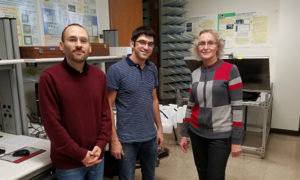For the original story and video by ABC-10’s Andy Kulie, click here.
Invisibility…it’s the stuff of science fiction and fantasy.
But new developments are being made that are bringing us one step closer to being able to make things disappear without the help of story book magic.
“We have the mathematical theories, but the question is how to realize it in practice,” said Ph.D. student Saeid Jamilan.
 Invisibility cloaking is one area of research in the young field of Transformation Electromagnetics.
Invisibility cloaking is one area of research in the young field of Transformation Electromagnetics.
By diverting the path of electromagnetic waves — such as those which make up visible light — around an object, one can essentially make that object disappear.
Since 2009, Dr. Elena Semouchkina has been leading Ph.D. students at Michigan Tech toward the cutting edge of this idea.
Now, a new design is bringing theory closer to reality.
“I contributed by designing a new cloak using anisotropic photonic crystals,” Jamilan added.
“They are materials which can be fabricated up to optical frequencies,” said Associate Professor of Electrical Engineering, Dr. Elena Semouchkina. “So we hope this technology will make all of these unconventional devices much more doable.”
While the current design doesn’t make an object invisible to the human eye, using state-of-the-art homebrew equipment, researchers are getting good results with microwaves.
“We do proof of concept experiments at microwaves,” Semouchkina said, “and then we do simulations from radio frequencies up to optics so we can actually project all of these results to other frequency ranges.”
Ph. D. student Navid Gandji added, “It is working very nice right now. We are going to somehow make it work better — increase the band of applications.”
The team is currently working to optimize the design and push the technology one step closer to a realm that would have been considered fiction not so long ago.
“It is somehow a portion of science fiction. It’s so young at this stage, but we are trying our best to make it true somehow,” said Gandji.
 Keweenaw Report Your Source for Local News and Sports
Keweenaw Report Your Source for Local News and Sports




